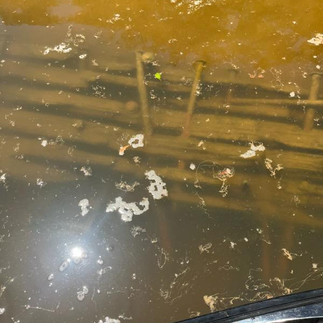Mysterious find in the Neches River surfaced in drought
- Sandi Saulsbury
- Aug 31, 2023
- 2 min read
The faint outline of the 100-year-old vessel still resting in its watery grave
By Sandi Saulsbury
In the hearts and minds of every aspiring armchair archaeologist, there is the dream of finding something long hidden that turns out to be of some historical significance. Recently, that is precisely what happened to 70-year-old Bill Milner of Buna.
The Ice House Museum in Silsbee’s curator, Susan Kilcrease wrote an article about a paddleboat that went down in the Neches River in 1849. After reading it, Milner decided to try to find the boat. And indeed if there was one, there had to be more. Milner set out to see what he could find.
With the recent drought in our area, the Neches River water level has dropped significantly. Milner explained, “I decided that I was going to take advantage of it while the water was so low. So, on August the 18th, I carried my jet ski to the river and began searching”.
Milner said that he went up and down the general area where the paddle boat was supposed to be located, but then he stumbled across the remains of something totally unexpected. He found a ship. In fact, as he was trying to understand precisely what he had found, Milner discovered that it was not just A ship, but he actually had discovered the remains of five World War I ships that had been sunk there for around 100 years! The largest of which was an astounding 40 feet wide and a whopping 260 feet long!
He reached out to Kilcrease to see if she knew anything about the find. Kilcrease admitted that she knew nothing about the ships and contacted the Texas Historical Commission for answers and spoke with Amy Borgens who is the Maritime Archaeologist.
Borgens was quoted as saying, “The wreck, sometimes visible to boaters and others using the river is one of more than a dozen vessels that had been abandoned after World War I.” Two of the wrecks were discovered in 1980, during a cultural resources management survey, but were not identified at that time. Then eight wrecks were discovered in 2004. Two years later, only six were found.
According to Borgens, “Altogether nearly 40 wooden hulled EFC vessels are in East Texas rivers, comprising one of the largest collections of WWI vessel abandonment sites in the U.S.”
According to Milner, the ships were built in 1923 and were never used during the war. Once the war was over, they were simply taken to the river and abandoned. Milner said that at some point, they were burned because everything above the water level was gone. All that remains is what was under the waterline.
The location of the ships will remain a secret. In a few weeks, maybe months, the water will rise again hiding the vessels for the next adventurer to stumble upon. It makes you wonder what else is out there; hiding under the waves, sand, or even in your own backyard, just waiting to be unearthed.
Stay curious and never stop dreaming!


















.png)